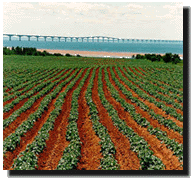
Prince Edward Island’s most important cash crop
is the potato. Our climate, north of the 46th
parallel, and our light, sandy soil are ideally suited to
high-quality potato production. As of 1997, 652 farms
were involved in potato production in the province. Most
farmers begin planting in May. However, in some areas, if
the soil and weather are right, planting can start as
early as April. Harvesting begins in September and then
the crop is stored, graded, packaged and delivered to
market.
The 1997–1998 potato season saw 112,000 acres of
potatoes planted and 111,200 acres harvested. The average
yield was 265 cwt. (cwt = hundred pounds) per acre, with
a total of 29.7 million cwt. Approximately 38 percent of
the total potato production was sold as tablestock or
processed on Prince Edward Island. A little over 43
percent was shipped out of province, and 7.5 percent was
used as seed for the next year’s crop.
 Over
the past several years, increasing prices for land and
machinery have led to higher costs to potato producers.
On the other hand, the Island’s reputation of
producing high-quality products in the seed and
tablestock markets has guaranteed Prince Edward Island a
solid international standing. Tablestock is sold locally
on the Island as well as in Atlantic Canada, Central
Canada, the United States, and internationally. Island
seed potatoes are sold to more than twenty countries on
five continents: North America, South America, Europe,
Africa, and Asia. The biggest buyers of Island potatoes
in 1997–1998 were New Brunswick, purchasing 2.7
million cwt. and the City of Toronto, Ontario, purchasing
2 million cwt. Another 3.6 million cwt. was exported to
foreign markets on other continents.
Over
the past several years, increasing prices for land and
machinery have led to higher costs to potato producers.
On the other hand, the Island’s reputation of
producing high-quality products in the seed and
tablestock markets has guaranteed Prince Edward Island a
solid international standing. Tablestock is sold locally
on the Island as well as in Atlantic Canada, Central
Canada, the United States, and internationally. Island
seed potatoes are sold to more than twenty countries on
five continents: North America, South America, Europe,
Africa, and Asia. The biggest buyers of Island potatoes
in 1997–1998 were New Brunswick, purchasing 2.7
million cwt. and the City of Toronto, Ontario, purchasing
2 million cwt. Another 3.6 million cwt. was exported to
foreign markets on other continents.
Potato farm sizes vary from a few hectares to larger
operations with several hundred hectares devoted to
potato production. The average size of a potato farm is
40 to 50 hectares. In an effort to improve soil quality,
reduce soil erosion, suppress disease, and control
insects—problems endemic to large-scale
monocultures—many potato growers are sowing cereal
and forage crops in rotation with potatoes. Emerging
awareness of Integrated Pest Management (IPM) strategies
is also helping Island potato growers to deal with insect
and disease problems in ways that are less damaging to
long-term soil quality and surrounding flora and fauna.
Prince Edward Island farmers began producing certified
potato seed in 1917, using the two standard varieties,
Irish Cobbler and Green Mountain. These two strains are
still grown frequently today. The Island’s natural
geographic isolation has kept our seed stock relatively
free from serious diseases and growers have kept pace
with market trends as new varieties have been introduced
over the years.
The most popular potato varieties grown on the Island are
Russet Burbank, Kennebec, Superior, Shepody, and Sebago.
Shepody and Sebago are early-maturing varieties (100
days), while the Russet Burbank, which is especially good
for French fries and baking, can take as long as 140 days
to mature. The Kennebec variety is a good table potato
and also produces a quality chip.
Fruits
and Vegetables | Field Crops
| Beef and Dairy | Swine
Poultry and Eggs | Emerging Commodities |
Beekeeping
